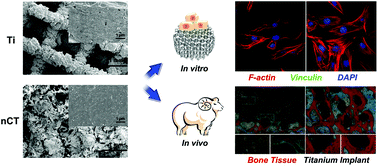当前位置:
X-MOL 学术
›
Biomater. Sci.
›
论文详情
Our official English website, www.x-mol.net, welcomes your
feedback! (Note: you will need to create a separate account there.)
Involvement of FAK-mediated BMP-2/Smad pathway in mediating osteoblast adhesion and differentiation on nano-HA/chitosan composite coated titanium implant under diabetic conditions
Biomaterials Science ( IF 5.8 ) Pub Date : 2017-11-07 00:00:00 , DOI: 10.1039/c7bm00652g Xiang-Yu Ma 1, 2, 3, 4, 5 , Ya-Fei Feng 1, 4, 6, 7, 8 , Tian-Sheng Wang 3, 4, 5 , Wei Lei 1, 4, 6, 7, 8 , Xiang Li 4, 9, 10, 11, 12 , Da-Peng Zhou 1, 2, 3, 4 , Xin-Xin Wen 1, 3, 4, 5, 6 , Hai-Long Yu 1, 2, 3, 4 , Liang-Bi Xiang 1, 2, 3, 4 , Lin Wang 1, 4, 6, 7, 8
Biomaterials Science ( IF 5.8 ) Pub Date : 2017-11-07 00:00:00 , DOI: 10.1039/c7bm00652g Xiang-Yu Ma 1, 2, 3, 4, 5 , Ya-Fei Feng 1, 4, 6, 7, 8 , Tian-Sheng Wang 3, 4, 5 , Wei Lei 1, 4, 6, 7, 8 , Xiang Li 4, 9, 10, 11, 12 , Da-Peng Zhou 1, 2, 3, 4 , Xin-Xin Wen 1, 3, 4, 5, 6 , Hai-Long Yu 1, 2, 3, 4 , Liang-Bi Xiang 1, 2, 3, 4 , Lin Wang 1, 4, 6, 7, 8
Affiliation

|
Chitosan (CS)-based hydroxyapatite (HA) composites have emerged as a novel strategy for promoting bone regeneration. Here nanophase HA/CS composite coated porous titanium implants (nCT) were fabricated and their biological behavior under diabetic conditions was investigated. We proposed that the focal adhesion kinase (FAK)-mediated BMP-2/Smad pathway played a role in mediating the promotive effect of nCTs on osteoblast adhesion and differentiation under diabetes-induced high reactive oxygen species (ROS) condition. To confirm the hypothesis, rat osteoblasts on bare titanium implants (Ti) and nCT were subjected to normal serum (NS), diabetic serum (DS), DS + NAC (a potent ROS inhibitor) and DS + cytochalasin D (an actin polymerization inhibitor). In vivo on diabetic sheep implanted with Ti or nCT showed that diabetes-induced ROS overproduction impaired osteoblast adhesion, evidenced by immunostaining of F-actin and vinculin and morphological observation through inhibition of FAK phosphorylation, which contributed to suppressed BMP-2-dependent Smad1/5/8 phosphorylation. nCT substrate reactivated the FAK-BMP-2/Smad pathway, thus reversing osteoblast dysfunction, which exerted a similar effect to NAC treatment on Ti. These effects were further confirmed by improved osteointegration within nCT in diabetic sheep, evidenced by micro-CT and histological examinations. Our study demonstrated that reactivation of the FAK-BMP-2/Smad pathway was involved in improving osteoblast adhesion and differentiation by nano-HA/CS composite coating, potentially directing biomaterial modification and biofunctionalization under diabetic conditions.
中文翻译:

FAK介导的BMP-2 / Smad途径参与糖尿病条件下纳米HA /壳聚糖复合涂层钛植入物介导成骨细胞粘附和分化的过程。
基于壳聚糖(CS)的羟基磷灰石(HA)复合材料已经成为促进骨再生的新策略。本文制备了纳米相HA / CS复合涂层多孔钛植入物(nCT),并研究了其在糖尿病条件下的生物学行为。我们建议在糖尿病诱导的高活性氧(ROS)条件下,粘着斑激酶(FAK)介导的BMP-2 / Smad途径在介导nCTs对成骨细胞粘附和分化的促进作用中发挥作用。为了证实这一假设,对裸钛植入物(Ti)和nCT上的大鼠成骨细胞进行了正常血清(NS),糖尿病血清(DS),DS + NAC(一种有效的ROS抑制剂)和DS +细胞松弛素D(一种肌动蛋白聚合抑制剂)的实验。 )。体内对植入Ti或nCT的糖尿病绵羊的研究表明,糖尿病引起的ROS过量生产会破坏成骨细胞粘附,这可以通过F-肌动蛋白和纽蛋白的免疫染色以及通过抑制FAK磷酸化的形态观察来证明,这有助于抑制BMP-2依赖性Smad1 / 5 / 8磷酸化。nCT底物重新激活了FAK-BMP-2 / Smad途径,从而逆转了成骨细胞功能障碍,这与NAC治疗Ti的作用相似。通过微CT和组织学检查证明,糖尿病绵羊nCT内骨整合的改善进一步证实了这些作用。我们的研究表明,FAK-BMP-2 / Smad途径的激活与纳米HA / CS复合涂层改善成骨细胞的粘附和分化有关,
更新日期:2017-11-07
中文翻译:

FAK介导的BMP-2 / Smad途径参与糖尿病条件下纳米HA /壳聚糖复合涂层钛植入物介导成骨细胞粘附和分化的过程。
基于壳聚糖(CS)的羟基磷灰石(HA)复合材料已经成为促进骨再生的新策略。本文制备了纳米相HA / CS复合涂层多孔钛植入物(nCT),并研究了其在糖尿病条件下的生物学行为。我们建议在糖尿病诱导的高活性氧(ROS)条件下,粘着斑激酶(FAK)介导的BMP-2 / Smad途径在介导nCTs对成骨细胞粘附和分化的促进作用中发挥作用。为了证实这一假设,对裸钛植入物(Ti)和nCT上的大鼠成骨细胞进行了正常血清(NS),糖尿病血清(DS),DS + NAC(一种有效的ROS抑制剂)和DS +细胞松弛素D(一种肌动蛋白聚合抑制剂)的实验。 )。体内对植入Ti或nCT的糖尿病绵羊的研究表明,糖尿病引起的ROS过量生产会破坏成骨细胞粘附,这可以通过F-肌动蛋白和纽蛋白的免疫染色以及通过抑制FAK磷酸化的形态观察来证明,这有助于抑制BMP-2依赖性Smad1 / 5 / 8磷酸化。nCT底物重新激活了FAK-BMP-2 / Smad途径,从而逆转了成骨细胞功能障碍,这与NAC治疗Ti的作用相似。通过微CT和组织学检查证明,糖尿病绵羊nCT内骨整合的改善进一步证实了这些作用。我们的研究表明,FAK-BMP-2 / Smad途径的激活与纳米HA / CS复合涂层改善成骨细胞的粘附和分化有关,











































 京公网安备 11010802027423号
京公网安备 11010802027423号